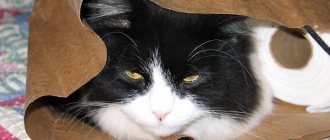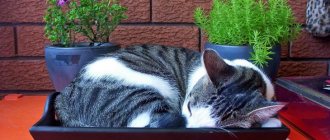Save the article:
Owners obviously do not bring cats into the house for the purpose of running around with floor rags and wiping up foul-smelling puddles left anywhere. to stop a cat from crapping : the peace of mind in the house and the comfortable coexistence of the family with the furry pet depend on it.
Furry pets can go to the toilet in flower pots, under and on the bed, on the carpet and in new shoes. A little more, and the apartment will become a cat's litter box...
When a cat shits in the wrong place, and does it with enviable consistency, any owner can lose his nerve. But you shouldn’t immediately scold the guilty purr, but take a closer look at the animal’s behavior and understand the reasons for the wet crime.
When to litter train a kitten
You need to carefully prepare for the arrival of a domestic kitten. Buy several trays and place them in different corners. Absorbent diapers may be required. It is necessary to begin training immediately. When the baby starts fussing, you can pick him up and carry him to the container.
In the end, he himself will choose a container to relieve his needs. Extra trays are removed, and the ones you like are moved to the toilet. The pet must understand that if he did something correctly, he will receive a reward treat.
Cat psychology
It is likely that the subtle psychology of cats is to blame for bad behavior. Why do animals that have always behaved “decently” and used a strictly defined place to perform their natural needs shit anywhere?
Think, perhaps you have offended your furry pet in some way? For example, they scolded him greatly, began to pay less attention, rarely petted him, or came home late from work. Maybe they hit the cat for being naughty or treated him roughly? In this case, there is a high probability that the pet is simply taking revenge on you. No matter how trite it sounds, you will have to apologize and improve relationships.
Often the reason for inappropriate behavior is moving to a new apartment. The absence of familiar smells and favorite places can be very stressful for the animal. In this case, the owners need to show maximum patience and help the pet get comfortable in the new place. Pay attention to him more often, play familiar games, build a new cozy bed or several shelves. Looking down at the world will make your pussy feel more confident.
You can help the fluffy “window” the new room. Take a dry, clean cloth and dry your cat thoroughly with it. Now use the same cloth to wipe the furniture, walls, doors, window sills and floors wherever you can get them. This way you will transfer the smell of the animal to objects, and they will no longer seem so alien and dangerous to him.
Why the kitten doesn't go to the litter tray: reasons
A kitten is a person who does not tolerate violence, so the following mistakes by the owner lead to abandonment of the tray:
- Punishment: the owner sees a puddle on the floor and punishes the pet. The kitten begins to perceive the owner not as the dominant individual in the pride, but as an enemy and resorts to deception: leaving piles in inaccessible places and puddles on the carpet. Fortunately, the liquid is well absorbed and traces of misconduct are invisible.
- Coercion: it’s one thing when a person notices that a pet is fussing, picks it up affectionately, and carries it to the tray. When this is done forcibly, after feeding, and held until defecation occurs, even a toilet-trained animal changes its habits and begins to shit where no one will disturb it.
- Dangers: on the way to the tray, a tormentor - a dog or a child - appears unexpectedly or expectedly. Therefore, the cat hides in a secluded place and does its business, which is not immediately detected by the smell.
- Untidy litter box: cats are clean animals, and at the same time, predatory ones. They will not sit in ambush where the smell might give them away.
- Repellent filler. Cats are capricious individualists. They may not like the smell or consistency. It's even worse if you like it. The pet will eat the pellets and become poisoned.
- Stress: renovations, rearrangement of furniture, moving, the birth of a child, the appearance of a new pet in the apartment causes the animal to mark its territory.
Be sure to read:
Why a cat shits on the bed: the main reasons, what to do, how the owner should behave, what not to do
When a pet appears in the house, the owner must explain to the household the rules for handling the kitten.
What are the reasons for this?
Everyone gets happiness in the form of a kitten in different ways. Some - after much thought. Being a meaningful choice, such pets often come into the home from a nursery or from a breeder, where enough time is devoted to their upbringing. Others strike out on their own, desperately fighting for survival on the streets or in shelters.
But whatever the kitten’s path to the heart, the hassle of getting used to a new place will be inevitable. It depends on the origin of the little cat how long it will take to find a solution to the most common problem: doing your business not somewhere, but in the tray.
If a kitten from a good family, upon arrival at a new home, hides in corners, behaves anxiously, ignores the litter box and pees anywhere, despite assurances of good upbringing, this means that he:
- is stressed from the new place and the loss of her mother cat;
- unfamiliar smells cause fear and mistrust;
- the new tray simply does not make you want to do your business in it.
The reasons for sabotage by less well-born street kittens lie in their past. For such a kitten, the very environment of a new home is unusual. Maybe he is afraid of people or does not understand what to do with the litter box. After all, it’s easy to shit on the street: the toilet can be found everywhere.
Situations when an already well-bred domestic kitten suddenly changed its behavior and began to leave puddles wherever it came into its head have slightly different reasons. Often the tray is not ignored, but simply becomes out of reach. For example, after surgery or during illness. Such cases themselves provide an answer to the question of why all surfaces that are near the kitten are at risk.
In addition, the kitten is as clean as adult cats. If there is something wrong in the tray, he will find a way out and start writing next to it. By capturing the moment when he just started doing this, you can prevent a lot of problems with cleanliness and peace of mind in the future.
In any case, having restored the retrospective of the life of a fluffy ball, we can say with 100% certainty why random things happen in the corners. It is on this “why” that measures to combat the consequences depend, as well as putting the pet once and for all on the right path.
How to stop a kitten from pooping in inappropriate places
The place where the event occurred is washed with water and sprinkled with vinegar or a repellent such as Antigadin. Some cat owners recommend covering areas from which they need to keep their pets away with foil.
A slippery and rustling surface will prevent you from concentrating. If a puddle or pile is found, the contents are collected on toilet paper and placed in a tray. Perhaps the pet will understand where he needs to go in case of need.
How to understand why a cat shits everywhere?
Before you begin to study ways to overcome a nasty habit, it is necessary to analyze the reasons for inappropriate behavior. Without a clear understanding of your motives, you will not be able to achieve a positive result. All the efforts of the owners will be in vain, and relationships in the house will go wrong.
There is a fairly impressive list of reasons why a cat began to shit anywhere. Each animal is different, so owners may have to work hard to solve the problem.
So, you noticed that the cat began to shit everywhere. What to do in this case? Let's figure it out.
Ways to train a kitten to use the litter box
If the kitten is already accustomed to the litter box, you should ask the sellers about its brand and purchase the same one. Otherwise, select a moderately deep litter box so that the pet can climb on it and not scatter the contents. There are several options to try: wood pellets, sand, bentonite clay.
You cannot use silicone granular litter for a kitten: a curious creature may swallow the balls. Since silica gel, which absorbs moisture and odors, is not suitable for a kitten, the filler will have to be changed frequently.
Pets' preferences are individual, so which tray he likes, with or without a grid, will become clear during the training process.
It should be noted that the place where the tray is located should be accessible to the pet around the clock. If there is a dog in the apartment, then you need to make the cat toilet inaccessible to it. Another option is to purchase a cat house or enclosure with a tray installed inside.
Preventive measures
It is much easier to prevent any problem than to solve it in a long and difficult manner. To prevent your pet from starting to defecate in the wrong places, you need to adhere to the following rules:
- The tray should be immediately placed in a quiet, slightly shaded and secluded place. There is no need to suddenly change its location.
- Replace the filler completely at least once a week. When changing brands, do this gradually, partially replacing the old filler with portions of the new one.
- It is necessary to provide your pet with a balanced and regular diet. There should always be access to fresh water.
- Periodically it is necessary to take tests for the presence of worms and give anthelmintic drugs for prevention.
- The pot should be washed with warm water and soap after each bowel movement, and disinfected once every 7–10 days.
The cat litter box needs to be disinfected once a week.
You should always praise and caress your pet for correct actions. You can reward him with various treats when he goes to the tray when needed.
Reason #8: the cat is marking its territory
The cat recently started peeing in the wrong places, but mostly goes to the litter box? Perhaps he is marking his territory. Here you will need either castration or constant mating with females so that the rut after sexual intercourse becomes dull and the need for marks disappears. Although the second option may not work, because... There are very sexy cats and those who doubt that the territory of the apartment belongs only to them, which means they continue to mark.
The problem of marks can also occur in cats, especially if there are several of them in the house. And in general, if there is more than one cat in a family, this is a provoking factor for marks. In this case, you need to try to normalize the relationship between the pets. And they need not one toilet for two, but... three. There should be one more tray than there are cats. The trays should be placed in different places: in those places where you most often find “gifts”.
We show attention and care
If everything is fine with the toilet, remember what recent events could have affected the state of the cat's soul. Perhaps you moved from your dacha to an apartment, and your cat suddenly found herself surrounded by smells that she had already lost the habit of, but couldn’t find her recent marks? Or perhaps there is a new smell in the house, especially a cat one?
An even more serious stress for a cat can be a change in family composition, the addition of a child or a new pet. In this case, a period of adaptation and the formation of new relationships is inevitable - we discussed this issue in detail in the article “Why do cats bury their feces.”
The most important thing to remember is that a cat begins to mark its territory when it feels threatened. If a cat’s world is stable, she has enough food, water and attention, and she feels safe, she will not have such a desire. Try to pay more attention to the animal, communicate more with it, do everything to make the cat feel that new residents or a changed environment do not threaten its well-being.
Folk remedies
In order to ensure that your cat is weaned from bad habits, regular preventive maintenance should be carried out.
The cat litter box should be placed in a quiet and secluded place.
The animal's nutrition must be complete. Water - in sufficient quantity, without restrictions. This will avoid problems with the urinary system. Regular deworming is also required.
If a problem does arise, then it should be solved quickly, but carefully - you cannot shout at the cat or hit it, as many animals will get scared and perceive this as a manifestation of aggression on the part of humans.
Using bleach
It is not recommended to use bleach, as it only masks the odor for a while. You can also “mark” places where the cat is not allowed to go, using double-sided adhesive tape (scotch tape) for this purpose - this will help the cat understand that it is forbidden to write here.
If nothing helps and the cat continues to pee in the wrong place, you can use special medications that correct behavior, since such violations may be associated with seasonal disruptions.
Traditional methods of dealing with the smell of cat urine
Cats have lived alongside humans for about 10,000 years. During this time, people managed to pick up odors that discourage cats from shitting where they shouldn’t. Not all of them are effective in our time. Moreover, each cat’s sense of smell is individual.
But you can, hoping for a positive effect, spread it out in places that have been washed from excrement:
- lemon, orange (you can put the peels in flower pots);
- mustard or very hot pepper;
- burnt paper or ashes;
- the owner's sweaty clothes.
Cat urine odors from objects, furniture, clothing and shoes can be eliminated using:
- iodine;
- alcohol;
- hydrogen peroxide.
As for bleach and vinegar, they are dangerous to health and completely useless: most likely, they will attract the pet even more to their favorite corner. Simply because they enhance the smell of urine.
Explanation of errors
This method involves a gentle influence of the owner on the animal. The peculiarity of this method is that it is necessary to constantly explain to the cat his mistakes. As soon as the animal shits in the wrong place, you need to lightly poke him in this place with his muzzle and say that he did wrong (your voice is very important). Next, you should take the kitten to the tray and sit it down.
To be effective, it is necessary to close the door to the room where the tray is located so that the animal senses the boundaries and smells it. As soon as the result is achieved, it is necessary to reward the cat by treating it with a treat. This method requires a person to invest time.
Using smells
In cases where the reasons for unwanted behavior are purely psychological, it is necessary to remember an important feature of cats: for them, the world is a map of smells. They apply them to everything that surrounds them, much like we write the names of streets and shops on a geographical map. If a cat went to the toilet in a certain place, it will return there and go again because it will be attracted to that place by the smell.
Therefore, it is best to wash the places where the cat has formed an illegal toilet with special products that fight off the cat’s odor very effectively. Read more about this in the article “Professional products: there will be no cat smell!”
Just do not use chlorine-containing products! Their effect will be the opposite. You can also use essential oils and scents that cats prefer to avoid; read about them in the article “The smell of what grass cats don’t like.”
In addition, there is another old folk way to calm a cat. Take any cloth, wipe your pet's fur with it, especially behind the ears, and then transfer this smell to the furniture and objects in your apartment. The cat will not have the desire to mark where the scent of its pheromones is already present, and in general it will feel safer.
Solving health problems
Let's say that before your cat always willingly used the tray and litter, and there have been no changes in her life recently. What then? It is best to take your pet to a doctor. Cats very often communicate their pain to us in this way. Get tested, check your internal organs using an ultrasound.
Sometimes urination on upholstered furniture is a consequence of urolithiasis: it hurts the cat to urinate, and he looks for a softer place, in the hope that this will ease his suffering. But only timely treatment can alleviate them, so do not waste time raising the cat, but run to the veterinary clinic.
Another possible reason for bowel movements everywhere is helminthic infestation. Do not neglect regular preventive administration of anthelmintic drugs!
Methods of punishment
Moreover, if you are illiterate, situations may arise when you need to punish your pet. (it’s even better to change the word and say “not to punish”, but to instruct, that is, to instill good manners.
To instill such manners, it is appropriate to highlight two main methods: psycho-emotional and physical. They are often combined and act in tandem. One way or another, you need to understand the main thing: there is no need to make the punishment cruel, by all means (probably, this fact should not be explained to the one who decided to place the animal at home and take care of it, but still.
Cruelty will not only achieve nothing for you, but can also ruin the animal. In addition, your animal most likely understands the prevailing prohibitions and actions that should not be performed, and violates such prohibitions more than ever for psychological reasons, perhaps it requires attention or something similar, but we will not go into the details of animal psychology.
Ideally, your sister performs the educational action in such a way as to simply and calmly make it clear: this action cannot be performed.
The most common methods are the following:
- Waving your finger in front of your nose is more than effective; animals don’t like it when you move your finger like this edifyingly.
- To turn up your voice - just don’t shout (screaming has no effect), but (be a menacing and impressive voice, although here, too, don’t overdo it with psychological pressure.
- The wiper is a universal tool that can make whipping sounds from a sharp touch to the floor, it can be used to lightly spank the cat itself, the main thing is that it is not enough to twist it and not to swing it too much.
- A spray bottle and splashing water - they trigger reflex equipment, if you spray a spray bottle in the cat’s face once, he will remember this suggestion for a long period.
- Sharaban on the nose or on the forehead - both options require softness, you just need to lightly indicate the touch, but, of course, do not confuse such nivation with stroking.
These methods can be combined (for example, a menacing squeal and waving a towel) or act separately.
One way or another, you need to carry out the intervention immediately after the offense and only when you see how a cat has misbehaved in front of you, before your eyes, and not after some period. She’s an animal, she may simply not understand what kind of offense you are doing to him like this. Therefore, act with a single sigh after or simply stop negative actions if possible, for example, use your voice - many cats react to the word “no”.
Summary
In conclusion, you should say a few words about your attitude towards punishing pets. The facts of the action (punishment) should not become an end in itself.
If you lash out at your pet, and especially if you get bliss from physical or mental pressure on your cat, in all likelihood, the problem is not in your pet’s misdeeds, but in your psychological condition. Here, the decision to consult a psychologist becomes quite relevant Perhaps, see a zoopsychologist. Therefore, before trying to control and educate someone else, try to carefully control yourself, because you are responsible for those you have tamed.
Game "cats and mothers"
Often the kitten is separated from its mother too early. This is a lot of stress for him. That's why the kitten shits - it's confused and scared. In this case, expecting him to fulfill your demands and desires is simply useless. Please be patient. After he has eaten, you can give him a light tummy massage. Stroking should be like licking a cat. Such touches stimulate the kitten's intestines, which provokes natural urges. Therefore, after stroking it, take it to the tray.
Opinions, advice and special remedies
There are also folk remedies that can discourage a cat from peeing in the wrong place. The following substances are excellent for these purposes:
- garlic, onion;
- alcohol, iodine;
- cloves, cinnamon;
- cayenne or regular black pepper;
- lavender;
- thyme;
- lemongrass;
- rue;
- vinegar essence.
Cats have a particular dislike for citrus fruits. In places chosen by cats for their “deeds”, you can lay out the peels of lemons or oranges. According to reviews from animal owners, some people find that spraying a tincture based on wormwood, garlic and onion peel helps. The product is taken into a spray bottle and sprayed in corners, under sofas and behind cabinets.
Some people recommend treating problem areas with bleach. Should not be doing that. Firstly, the unpleasant smell quickly disappears, and secondly, many animals simply adore it. If your cat is one of these, she will only triple her efforts. There are several other, much more effective ways to correct an animal’s behavior:
- Take the cat into custody - lock it in a small room, where you place a tray and favorite toys with it. Let your kitty out only while feeding. After she begins to use the tray for its intended purpose, you can begin to let the cat out into other rooms for a short time.
- Praise the animal after each visit to the tray. If it's a small kitten, you can play with it right on the spot.
- Cover the areas selected for errands with double-sided tape. When the cat's butt sticks to it, the animal will not like it very much.
- Wash the soiled areas thoroughly and place small bowls of food there. Cats usually don't shit where they eat.
- Wet a napkin in the puddle the cat made, and then place it in the tray. This will make it easier for the animal to find the “right” place.
There are a lot of options for weaning a cat from a bad habit. The main thing is to act systematically, with love and in no case be cruel.
The period of sexual hunting
It is impossible to deceive nature, therefore, if a male cat is not neutered, then the period of sexual heat inevitably begins.
There are three options to solve the problem:
- Provide the animal with the opportunity to realize its instincts - to mate.
- Use special hormonal drugs to prevent or interrupt estrus. Not the best solution due to the likelihood of undesirable consequences for the pet’s health.
- Castration (sterilization) of a cat. The cat will not go on a spree after this operation, but it is impossible to definitely guarantee that the pet will no longer mark. In case of stress, castrated animals may begin to do this.
Cleanliness and force of habit
Just like people, cats have their own preferences, which also apply to the toilet.
When organizing a “latrine”, the owner should pay close attention to various details:
Regardless of the shape, size and type of filler, the tray must be clean. Many owners note that their pets do not go to the toilet if there is even a “hint” of previous bowel movements in it. Some cats furiously “bury” a puddle until the owner cleans it up
Such “cleanliness” is, rather, caution. Indeed, in nature, feces and urine “give away” animals and can bring “uninvited”, dangerous guests into the lair
However, for most animals, it is enough for the tray to be cleaned regularly and the litter to be partially replaced. In this case, once a week it is necessary to completely replace the material and thoroughly clean the container itself.
Tray size. Often, owners, having once bought a litter box for a kitten, forget to replace it with a larger container. It becomes very problematic for a significantly older cat to “relieve” itself on the “children’s potty”, and he goes in search of a more convenient place. The tray should be long enough and moderately deep so that the cat can turn around in it and rake in the way it is comfortable for her. There are also approximate calculations on this score - the length of a suitable container is 50% greater than the length of the animal’s body. Of course, the tail is not taken into account in this case.
Tray location. Most cats value comfort and privacy, which means it is recommended to place the tray away from drafts and prying eyes. Particularly shy cats require closed containers equipped with walls and a lid. As a rule, a suitable tank is selected empirically, based on the individual preferences of the pet.
Number of trays. If the animal is extremely clean, then experienced owners advise placing 2 containers at once. The latter is especially important when the owner is often away from home for a long time and cannot clean the tray every time the pet goes into it. Two cats will need 2-3 trays, and three cats will need 3-4...
Cleaning with disinfectants Chlorine-containing agents and vinegar solutions do an excellent job of eliminating odor, urinary stone deposits and various pathogens. However, these same products have a pungent odor and are often used to stop a cat from peeing anywhere. What to do in this case? First of all, you should wash the tray regularly using regular laundry soap, rinse it thoroughly and wipe it dry. If you do this in a timely manner, the container will remain clean without any signs of stone or “bad amber.”
- how to stop a cat from marking its territory;
- how to get rid of the smell of cat urine;
- how to train a kitten to use the litter box.
Check the tray and change the filler
First, inspect your pet's litter box. Isn't it too small for her? Have you recently changed the filler? It may be worth changing it to another one, for example, a silica gel to a bentonite one, or even starting to use a flower pot, especially if the cat has already chosen it for the toilet.
Is the litter box always clean and dry? Perhaps she doesn't like the new air freshener or detergent you're using? Many smells that seem pleasant to us have a repellent effect on cats. You should not place the tray where you feed your cat; she will not defecate where she eats.
For bad behavior
What can be the manifestation of bad cat behavior? For example, she may sharpen her claws on furniture or tear wallpaper at the bottom of the wall. Also, torn curtains, an overturned flower pot, or the habit of stealing the owner's food from the table can serve as a reason for punishment. In all cases, physical impact is something that should not be done.
- The most popular method of punishment is spraying the animal with water, because everyone knows the negative attitude of cats towards this liquid. To do this, of course, you don’t need to run after the animal around the apartment with a basin and pour several liters of water on top of it. And then it will be difficult to clean up the puddle, and consequences such as water getting into the ears may not have a very good effect on the pet’s health. A spray bottle is perfect for this method. It is advisable to keep it always at hand so that punishment follows immediately after the prank.
- Another punishment option is a loud, unexpected sound. To prevent pranks at the very beginning, it is enough to throw a book or keys near the cat so that the sound of the fall distracts it. You can simply clap your hands loudly or raise your voice. Cats respond well to the intonation of their owners, without even understanding what exactly is being said.
But before you punish, try to figure out why the cat does what it does. Maybe she simply doesn’t have enough attention, and thus is trying to attract him. Or her habit of stealing food from the master's table is due to lack of nutrition. And to prevent ragged furniture, purchase a scratching post, and the problem may solve itself.
Woman scolds cat for breaking a vase
Precautionary measures
People who fought and overcame this problem give the main advice: be patient and don’t rush off the handle. Try, try many times, try in different ways! The way of the whip, including, has the right to life, but be careful when choosing punishments for the animal:
Be careful and persistent in teaching your cat good habits.
- Punishment must be done immediately and after the fact;
- The punishment must be specific;
- The punishment should not be long-lasting. The working memory of cats, like all animals, is short, and after a while the pet will forget its “sin”;
- The punishment must be safe for the life and health of the pet.
Otherwise, punishment will only create helplessness and uncertainty in the animal, which can lead to unpleasant consequences. Also, be consistent. Do not make exceptions by punishing every other time. One way or another, do not forget that you are dealing with an animal. Behind changes in his behavior there can be either a trifle (in the owner’s opinion!) or an illness. Therefore, take wet slippers seriously. Don’t be cruel, because, as you remember, “A kind word is nice to a cat!”
What not to do
First of all, accept the fact that the problem of ignoring the litter box is a process that requires a set of educational measures. A miracle will not happen in a couple of days; your pet will need your patience and constant attention.
Physical punishment and shouting are unacceptable: a small kitten cannot be spanked or scolded even in a playful manner; the animal’s unformed psyche may incorrectly recognize such a behavior, which can lead to trouble in the future. The pet will see you as a threat and will begin to hide and look for a secluded place to defecate. Often this is the space under furniture or hard-to-reach corners of the room.
Punishment will form a reflexive fear in the pet of its owner
Poking your pet's muzzle into a puddle is also unacceptable: the animal will remember this place because of the pungent smell of urine, and in extreme cases, it will become very angry. Wash areas with strong-smelling products and remember that the only place where the kitten's smell should be present is its litter box.











